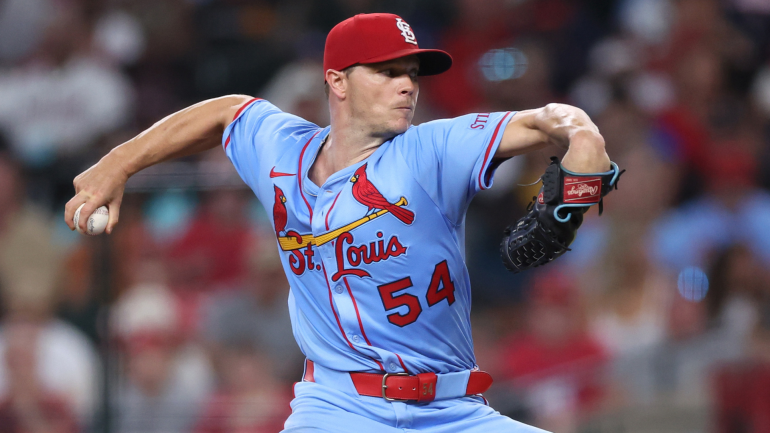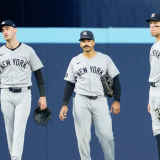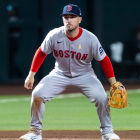Sonny Gray trade grades: Why Red Sox and Cardinals both get an 'A' in deal for veteran starter
Gray, 36, is heading to Boston, while St. Louis gets a return with both stability and upside

The Red Sox and Cardinals agreed to a three-player trade on Tuesday that will send veteran starter Sonny Gray to Boston in exchange for right-hander Richard Fitts and lefty Brandon Clarke. The Cardinals are also expected to send $20 million to the Red Sox to help pay down Gray's salary.
As is always the case at CBS Sports, a notable trade means that I am here to offer near-instant analysis. That includes commentary on the involved players and their futures, as well as a letter grade that sums up each team's work.
Before getting to the analysis, here again are the full terms of the trade.
- Red Sox receive: RHP Sonny Gray, $20 million
- Cardinals receive: RHP Richard Fitts, LHP Brandon Clarke
Onward.
Red Sox grade: A
Here, the Red Sox not only leveraged their pitching depth to land another quality starter, they did it while creatively maintaining financial flexibility that should come in handy throughout the winter.
Gray, 36, might be the most underrated pitcher of his generation. Across parts of 13 seasons, he's amassed a 117 ERA+, a 3.10 strikeout-to-walk ratio, and more than 33 Wins Above Replacement. He's logged at least 150 innings in each of the past three seasons, and last year's inflated ERA shouldn't cause too much concern. If you compare his metrics on a year-to-year basis, he saw improvements in 2025 in both his average exit velocity and his walk rate (and therefore his strikeout-to-walk ratio).
Gray's sustained success can be credited to his quality breaking balls and control. His four-seam fastball lost another tick last season, dropping it to 91.7 mph on average, and it's a testament to the aforementioned factors that he's been so productive anyway. If you're the Red Sox, you're comfortable assuming he'll be an average or better starter for another year, making it easy to slot him into a rotation that will also include Garrett Crochet, Brayan Bello, and some combination of a returning Patrick Sandoval, Kutter Crawford, and Connelly Early.
Gray is expected to rework his contract as part of the trade, according to MLB.com. Instead of being owed $35 million in salary with a potential $5 million buyout on an option for next season, he'll now possess a $31 million salary and will receive a guaranteed $10 million buyout. In other words, Gray is guaranteed more money overall, he'll just have to wait a longer time to collect it.
Meanwhile, the Cardinals' $20 million infusion basically halves Gray's luxury-tax calculations, leaving the Red Sox with around $20 million between their projected CBT number and the first tax line. The Red Sox will pay the luxury tax this year for the first time since 2022. It stands to reason that they'll make use of that bumper to build a roster that can muster another trip to the playoffs.
Cardinals grade: A
The Cardinals were quiet last winter as they planned out their transition from John Mozeliak's leadership to Chaim Bloom's. Now that Bloom is officially in charge of baseball operations, he's not wasting much time reworking the roster to his liking. The process that started with Tuesday's Gray trade, a deal that netted the Cardinals a readymade Gray replacement and a tantalizing upside play.
Fitts, 26 in a matter of weeks, has compiled a 3.97 ERA (105 ERA+) and a 2.13 strikeout-to-walk ratio in 15 big-league appearances over the past two seasons. His 2025 campaign was ravaged by injury. First, he missed more than a month after straining a pectoral muscle. Then, following his return to the majors, he had his season end after experiencing neuritis in his throwing arm.
So much of pitching revolves around keeping batters honest and creating tough optical angles. Fitts has both dynamics working in his favor. He threw five pitches at least 9% of the time last season, and all of them graded as average or better in the eyes of the analytic models. That group includes a mid-90s fastball and a sweeper that, in a smaller sample, generated a 40% whiff rate. Fitts marries that broad arsenal to an interesting release point. He ranked in the 70th percentile in extension, or distance from the pitching rubber to release, yet his higher arm angle enables his pitches a steeper angle to them than what is typical for pitchers who get a similar distance down the mound.
Provided Fitts is healthy come the spring, he ought to spend considerable time in St. Louis' rotation. Injury risk aside, he's the "stable" portion of the return that's ready to provide immediate production.
The other pitcher, Clarke, is the proverbial long-term moonshot who will test the Cardinals' new player development staff
Clarke, 22, split last season between A-ball affiliates. In 14 total appearances, he managed a 4.03 ERA and a 2.22 strikeout-to-walk ratio, albeit while averaging more than six walks per nine innings. His arsenal includes a fastball that sits in the mid-90s and a devastating breaking ball, and his low release point fits the modern preference. The drawback is that Clarke's arm action requires a long, sweeping stroke and the kind of elbow creep that may always impact his command and his health. If the Cardinals can help him make any progress with his location, he could turn this into a lopsided swap.






















